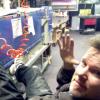Sooo I decided not to get a new car and to 'reward' myself for saving $$ on that I bought a Supermax 19/38 at Rockler. They had a 10% off sale and I had $65 on a gift card and was tired of using a router sled to flatten end grain cutting board I've been making.
I passed on the $90 casters Supermax sell. Seriously? $90?? I spent $40 on casters and hardware at home depot and made another shelf on the bottom.
I used it last night for the 2nd time and had a terrible time with some 80 grit paper. I should have started with 60 that was my first error. After several passes with 80 all of sudden dark lines and little gauges on the inner motor side. I check paper and it loaded a little. Use the gum stick thing to clean paper and notice it's loose on the motor side where it clips in. That clip is a PITA or I'm doing something wrong.
I pull that 80 off, put on 60 and get the board dialed in. Try to reuse the 80 but it's toast. The inboard (motor side) first 2" of paper is marred and wont sit flush when turned on so it leaves a mark. Need a new piece of 80 now.
I also noticed that sometimes the infeed roller wont go up to accept the board. I'm not taking off a lot. I thought I checked for parallel but will do that again. Any tips on this?
What about paper? I wanna buy 3" rolls and cut my own. 2sand.com has great deals, best I've seen. About $22 per roll after shipping and that enough for 4 wraps of the drum.
I did notice my board is not 100% flat. After a glue up on an endgrain board, often times some pieces are higher or lower by a 1/16" maybe 1/8". I was hopping the drum sander will get these board flat so I don't have to put rubber feet on them.
Any tips in using it to get a cutting board flat? I envisioned it similar to a planer where it takes off the high spots first, I could be wrong.




 Reply With Quote
Reply With Quote





